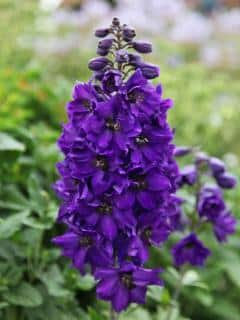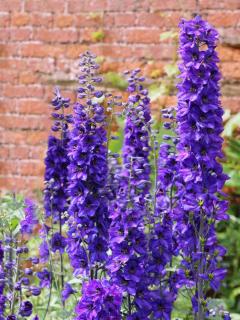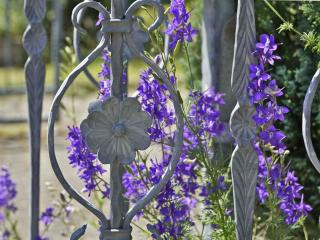

Pacific Giant delphinium (Delphinium elatum ‘Pacific’) are tall perennial plants. They produce dense candles of flowers in a mix of white, violet, and blue.
Key Giant delphinium facts:
Latin Names: Delphinium Pacific, Delphinium elatum
Common Name: Pacific giant larkspur
Family: Crassulaceae
Type: perennial plant
Height: 120 to 200 cm
Exposure: bright, partial shade
Soil: rich, moist soil
Foliage: deciduous – Flowering: summer
The giant Pacific delphinium’s large, eye-catching flowers densely cover the flower spike, emitting a subtle fragrance. The blooming occurs in summer and lasts for 100 to 120 days (nearly 4 months!).
Giant delphinium thrives along fences and mixed borders in sunny gardens.
Giant delphinium is perfect to pick beautiful cut flowers. It fits in small gardens, and copes well in windy areas where other large perennial plants are more prone to damage. However, remember to stake the plants to protect them from stronger winds.

While giant delphinium needs sunlight, it is better not to plant them wherever it gets too hot in the garden. Add plenty of organic matter or compost to the planting area: it’ll help retain moisture. Plant the delphiniums at ground level, not too deep. With good growing conditions and a summery climate, delphiniums can be absolutely fabulous.
Due to their heavy flower spikes upheld by slender, hollow stems, gusts of wind and rain can be a problem.
Pacific Giant delphinium is surprisingly easy to grow from seeds. Some varieties will even bloom in their first year! Seeds germinate easily, within 10-15 days, and quickly develop into robust plants.
Once the risk of frost has passed and the plant is of reasonable size:
Once well settled-in, Pacific Delphinium reliably grows back every year. The single main task in terms of care is helping the tall flowers stay upright early in the season, with stakes.

Pacific Giant candle larkspur requires protection against slugs. You need to pay careful attention to slug protection. Slugs are attracted to tender, fresh shoots that emerge in spring. Protecing against slugs is essential.

For a bouquet of giant delphiniums, it may be easier to create a simple cage using 3 to 5 stakes and then use flexible ties to connect the stems to the supports. You can also use flexible branches, such as those from a Cornus, to create a round support.
Carefully check the variety, as many giant delphiniums can grow very tall. Some varieties of Delphinium Pacific Giant, once established, can reach over 6 feet (1.5 m)! Tall stakes are necessary to support the blooms.
If your garden is exposed and prone to windy conditions, it may be more practical to grow shorter varieties.
There are three main groups of giant delphiniums:
Bees are attracted to giant delphiniums, drawn in by the beautiful intense blue color: bees are fond of blue flowers.
Do not ingest seeds or any other part of the plant, they’re toxic.